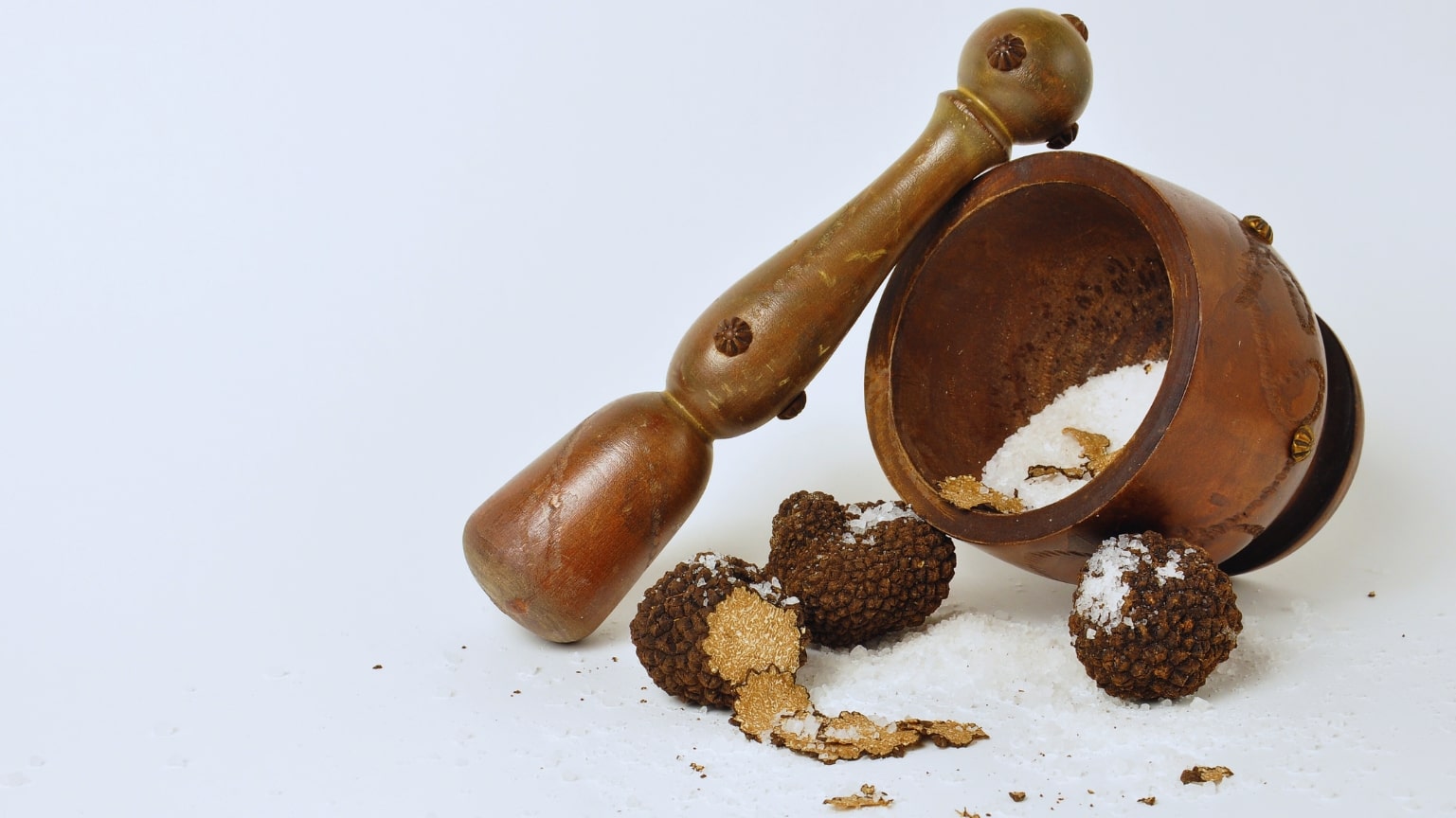
Introduction
Truffle salt, a luxurious and aromatic seasoning, has captured the attention of food enthusiasts and culinary connoisseurs worldwide. Combining the earthy essence of truffles with the purity of salt, this exquisite seasoning offers a delightful fusion of flavors that elevate dishes to new heights of gastronomic delight. In this comprehensive exploration, we delve into the origins, production methods, flavor profiles, and culinary applications of truffle salt, uncovering the secrets behind its allure and culinary prestige.
Origins of Truffle Salt
Truffle salt traces its origins to the culinary traditions of Europe, where truffles have been revered as a rare and prized ingredient for centuries. Truffles, the underground fungi prized for their distinctive aroma and flavor, have long been regarded as a symbol of luxury and indulgence in gastronomy. The use of truffles in cooking dates back to ancient times, with historical records documenting their consumption by ancient civilizations such as the Greeks and Romans. Over time, truffle salt emerged as a convenient way to impart the flavor of truffles into dishes, allowing chefs and home cooks to enjoy the luxurious taste of truffles without the need for fresh truffles.
How is Truffle Salt Produced?
Truffle salt is typically made by infusing high-quality sea salt with either real truffles or truffle flavoring. In traditional production methods, real truffles are finely chopped or shaved and mixed with sea salt, allowing the salt to absorb the aroma and flavor of the truffles over time. This results in a rich and aromatic seasoning with the unmistakable taste of truffles. Alternatively, truffle flavoring or essence may be added to sea salt to create a truffle-flavored salt. While not as intense as salt infused with real truffles, truffle-flavored salt still offers a deliciously decadent taste reminiscent of truffles.
How Does Truffle Salt Taste Like?
Truffle salt boasts a complex flavor profile characterized by earthy, nutty, and umami notes, with a subtle hint of garlic and mushroom. The intensity of the truffle flavor can vary depending on the type of truffle used and the production method employed. White truffle salt, made with rare and highly prized white truffles, tends to have a more delicate flavor profile with floral and garlic undertones. Black truffle salt, crafted with robust black truffles, offers a bolder and more pronounced truffle flavor with earthy and nutty nuances. Truffle salt may also be infused with other complementary ingredients such as garlic, herbs, or Parmesan cheese, further enhancing its complexity and depth of flavor.
Culinary Applications
Truffle salt is a versatile seasoning that can be used to elevate a wide range of dishes, from simple to sophisticated. Its rich and aromatic flavor makes it a perfect finishing touch for a variety of foods, including pasta, risotto, eggs, roasted vegetables, salads, and popcorn. A sprinkle of truffle salt can transform ordinary dishes into extraordinary culinary creations, adding depth, complexity, and a touch of luxury to every bite. Truffle salt can also be used as a gourmet garnish for hors d’oeuvres, charcuterie boards, and artisanal breads, showcasing its culinary versatility and sophistication. Additionally, truffle salt pairs beautifully with other premium ingredients such as foie gras, caviar, and fine cheeses, creating unforgettable flavor combinations that delight the senses.
Cultural Significance
Truffle salt holds cultural significance in regions where truffles are highly prized, such as Italy and France. In these culinary traditions, truffles are celebrated as a symbol of luxury and refinement, and truffle salt is revered as a prized seasoning that embodies the essence of truffles. Truffle salt has also gained popularity in international cuisine, where it is embraced by chefs and food enthusiasts alike for its unique flavor and versatility. Its association with luxury and indulgence has made truffle salt a sought-after ingredient in gourmet kitchens and a coveted addition to the pantry of discerning home cooks around the world.
Health Considerations
While truffle salt adds rich flavor to dishes, it’s important to use it in moderation as part of a balanced diet. Like all salt-based seasonings, truffle salt contains sodium, which can contribute to health issues such as high blood pressure and heart disease when consumed in excess. Therefore, it’s advisable to enjoy truffle salt as a flavorful accent in dishes rather than as a primary seasoning. By incorporating truffle salt mindfully into meals, you can savor its luxurious taste while maintaining a healthy lifestyle.
FAQ about Truffle Salt
Why is truffle salt so expensive?
Truffle salt commands a high price due to several factors contributing to its rarity, labor-intensive production process, and luxurious culinary appeal. The primary factor driving the expense of truffle salt is the scarcity and high cost of truffles themselves, particularly the rare and highly prized white and black truffle varieties. Truffles are notoriously difficult to cultivate, growing only in specific soil conditions and climates, and are often foraged by skilled hunters and trained dogs in select regions of Europe.
The process of infusing high-quality sea salt with real truffles or truffle flavoring is also intricate and time-consuming, requiring meticulous attention to detail to ensure the salt absorbs the delicate aroma and flavor of the truffles.
Additionally, truffle salt is considered a gourmet delicacy, associated with luxury, indulgence, and culinary refinement, which further contributes to its premium price tag. Overall, the combination of the rarity of truffles, the labor-intensive production process, and the luxurious culinary appeal of truffle salt justify its higher cost compared to other seasonings.
How do you make truffle salt at home?
Does truffle salt go bad?
Truffle salt, like other salt-based seasonings, has a long shelf life and typically does not spoil or go bad in the traditional sense. However, its flavor and aroma may degrade over time due to exposure to air, moisture, and light. To prolong the freshness and quality of truffle salt, it should be stored in a cool, dry place away from direct sunlight and humidity, such as in a sealed container or spice jar in a pantry or cupboard. Proper storage practices help prevent clumping and preserve the delicate aroma and flavor of the truffle-infused salt. While truffle salt may lose some of its potency over time, it is generally safe to consume even past its best-by date, although the flavor may not be as vibrant as when it was first purchased.
Should truffle salt be refrigerated?
Truffle salt does not need to be refrigerated and is best stored in a cool, dry place away from direct sunlight and humidity. Refrigeration can introduce moisture, which may cause the salt to clump and compromise its texture and flavor. Additionally, the fluctuating temperatures of a refrigerator can affect the delicate aroma and flavor of the truffle-infused salt. To maintain the freshness and quality of truffle salt, it is recommended to store it in a sealed container or spice jar in a pantry or cupboard where it can remain stable and dry. Proper storage practices help preserve the distinctive taste and aroma of truffle salt, ensuring optimal enjoyment in culinary creations.
Which is better, white or black truffle salt?
The preference between white and black truffle salt ultimately depends on personal taste and culinary preferences. White truffle salt, made with rare and highly prized white truffles, offers a delicate and nuanced flavor profile with floral, garlicky, and earthy undertones. Its subtle aroma and delicate taste make it ideal for dishes where a lighter truffle flavor is desired, such as creamy pasta sauces or risottos.
On the other hand, black truffle salt, crafted with robust black truffles, delivers a bolder and more pronounced truffle flavor with earthy, nutty, and umami notes. Its intense aroma and rich taste make it well-suited for heartier dishes like roasted meats, grilled vegetables, or scrambled eggs.
Conclusion
In conclusion, truffle salt stands as a testament to the exquisite marriage of luxury and flavor in the culinary world. From its ancient origins to its modern-day applications, truffle salt has captivated the palates of food enthusiasts and chefs with its rich and aromatic taste. Whether used to enhance everyday dishes or elevate gourmet creations, truffle salt offers a tantalizing fusion of earthy, nutty, and umami flavors that elevate the dining experience to new heights of culinary excellence. As we continue to explore the boundless possibilities of gastronomy, let us celebrate the decadent allure of truffle salt, a true treasure in the realm of gourmet seasonings.
